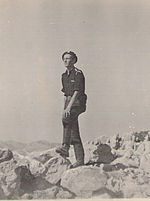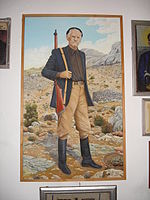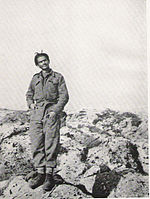- Damasta sabotage
-
The Damasta sabotage (Greek: Το σαμποτάζ της Δαμάστας) was an attack by Cretan resistance fighters led by British Special Operations Executive officer Captain Bill Stanley Moss MC against German occupation forces in World War II. The attack occurred on 8 August 1944 near the village of Damasta (Greek: Δαμάστα) and was aimed to prevent the Germans from assaulting the village of Anogia.[1][2][3]
Contents
Background
On 7 August 1944, Feldwebel Josef Olenhauer (known to the locals as "Sifis", the local diminutive for his name, quite widespread in Crete) and ten men of the German garrison based in Yeni Gave (Greek: Γενί-Γκαβέ, present day Drosia - Greek: Δροσιά) went up to the village of Anogia in search of concentration camp labourers. Olenhauer ordered his men to round up selected males in order to force them to march towards Rethymno. The villagers refused to come and so in retaliation, fifty hostages were taken. On leaving, the Germans were surrounded by local andartes, who attacked the detachment, freeing the hostages and killing all the Germans. Despite the success of their move, the villagers of Anogia feared that reprisals from the Germans were imminent and therefore took to the mountains and the local resistance.
Ambush
On the following day, August 8th, a resistance group commanded by the British Special Operations Executive officer Captain Bill Stanley Moss MC consisting of eight Cretans from Anogia organized into EOK and six escaped Russian soldiers, marched to the main road connecting Rethymno and Heraklion.
They chose an ambush site by a bridge in the Damastos location, one kilometer west of the village of Damasta and mined it with Hawkins grenades, preparing themselves for the German reaction. After destroying various passing vehicles, among which was a lorry carrying military mail to Chania, the German force targeting Anogia finally appeared. It consisted of a truck of infantrymen backed up by an armoured car.[1] The partisans attacked the German troops and Moss destroyed the armoured car by dropping a grenade into the hatch. In total 40 to 50 Germans and one Russian partisan were killed in the clash that followed. Cretan partisan Manolis Spithouris (Ntampakomanolis) was seriously wounded in the abdomen.[4][5]
The operation is described in full in Moss's book A War of Shadows and commemorated at Damasta and the Historical Museum of Crete.[6]
Aftermath
The expediency of the ambush in Damasta has been strongly disputed. Whilst Moss had hoped that it might have saved Anogia, Friedrich-Wilhelm Müller, the German commander in Crete, would not let Anogia go unpunished and had further strategic reasons for reprisals and terror across Crete in order to assist the German planned evacuation from much of the island to Chania.[3] Anogia dwellers had been actively involved in, and given refuge to, the resistance for many years, had killed the Sergeant Commander Olenhauer and the garrison from Yeni-Gave and had also provided shelter to the abductors of General Heinrich Kreipe. His Order reads:-
“ORDER BY THE GERMAN GENERAL COMMANDER OF THE GARRISON OF CRETE – “Because the town of Anogia is the centre of the English Intelligence on Crete, because the people of Anogia committed the murder of the Sergeant Commander of the Yeni-Gave, as well as of the garrison under his orders, because the people of Anogia carried out the sabotage of Damasta, because in Anogia the guerrillas of the various groups of resistance take refuge and find protection and because it was through Anogia that the kidnappers with General Von Kreipe passed using Anogia as a transit camp, we order its COMPLETE DESTRUCTION and the execution of every male person of Anogia who would happen to be within the village and around it within a distance of one kilometre” CHANEA 13TH AUGUST 1944, THE GENERAL COMMANDER OF THE GARRISON OF CRETE, H. MULLER.Thus, Müller ordered that Anogia should be razed to the ground and every male inhabitant found in the village executed. As a result, about 50 residents of Anogia were shot, the village was systematically pillaged and eventually destroyed.
On August 21, the Germans executed 30 men from the village of Damasta after accusing them as accomplices for not having given warning about the ambush and swept their village away.
Müller was convicted for this and other war crimes.[3] He was sentenced to death on 9 December 1946 and executed by firing squad 20 May 1947.[7]
References
- ^ a b Beevor, Antony. Crete: The Battle and the Resistance, John Murray Ltd, 2005, pp.315-6. ISBN 0-14-016787-0
- ^ Moss, W. Stanley. A War of Shadows, T V Boardman and Co Ltd, 1952. pp45-64
- ^ a b c "Psychoundakis, George. The Cretan Runner:His Story of the German Occupation, John Murray Ltd, 1955. The Folio Society, 2009 p178". http://en.wikipedia.org/wiki/George_Psychoundakis.
- ^ Moss, W. Stanley. A War of Shadows, T. V. Boardman and Co Ltd, 1952. pp45-64
- ^ Το σαμποτάζ της Δαμάστας 62 χρόνια μετά, Πατρίς onLine, 7 Αυγούστου 2006
- ^ "Historical Museum of Crete". http://www.historical-museum.gr/en/index.html.
- ^ "History of the United Nations War Crimes Commission and the Development of the Laws of War. United Nations War Crimes Commission. London: HMSO, 1948". http://www.ess.uwe.ac.uk/WCC/warcrimgenrls.htm.
Greece during World War II 1940–41 Balkans Campaign Occupation and Resistance Greek government in exile Battles: Elaia–Kalamas · Pindus · Morava–Ivan · Klisura · Trebeshina · Italian Spring Offensive
Commanders:
 Greece
Greece
Ioannis Metaxas · Alexander Papagos · Charalambos Katsimitros
 Italy
Italy
Sebastiano Visconti Prasca · Ubaldo Soddu · Ugo Cavallero · Giovanni MesseBattles: Metaxas Line · Vevi · Kleisoura Pass · Thermopylae · Crete
Commanders:
 Greece
Greece
Alexander Papagos · Georgios Tsolakoglou
 British Expeditionary Corps
British Expeditionary Corps
Henry Maitland Wilson · Thomas Blamey · Bernard Freyberg
 Germany
Germany
Wilhelm List · Kurt StudentOccupying powersOccupation Authorities:
 Germany
Germany
Günther Altenburg · Hermann Neubacher · Walter Schimana · Alexander Löhr · Hellmuth Felmy
 Italy
Italy
Pellegrino Ghigi · Carlo Geloso
 Bulgaria
BulgariaAtrocities: Kondomari · Kandanos · Doxato · Kommeno · Kalavryta · Distomo · Domenikon · Drakeia · Cephalonia · Paramythia · Mesovouno · Pyrgoi · Viannos · Kedros · Chortiatis · The Holocaust in Greece · Great Famine
CollaboratorsPeople: Georgios Tsolakoglou · K. Logothetopoulos · Ioannis Rallis · Georgios Poulos
Organizations: Collaborationist government · Security Battalions · ESPO · EEE · Greek National Socialist Party
Secessionists: Principality of the Pindus · Ohrana · Cham collaboration (Këshilla)
People: Aris Velouchiotis · Stefanos Sarafis · Georgios Siantos · Markos Vafiades · Evripidis Bakirtzis · Andreas Tzimas
Organizations: KKE · ELAS · PEEA · EPON · E.A. · OPLA · SNOF
Operations: Ryka · Mikro Chorio · Gorgopotamos Bridge · Fardykambos · Sarantaporo · Kournovo Tunnel
Non-EAM ResistancePeople: Napoleon Zervas · Georgios Kartalis · Dimitrios Psarros · Komninos Pyromaglou · Alexander Papagos · Kostas Perrikos · George Psychoundakis
Organizations: EDES · EKKA · YVE/PAO · PEAN · ΕΟΚ · E.S. · MAVI · Other
Operations: ESPO bombing · Gorgopotamos Bridge · Fardykambos · Agia Kyriaki · Milia · Skala Paramythias · Xirovouni · Menina · Dodona
Atrocities: Expulsion of Cham Albanians
British Mission in Greece (SOE)People: Eddie Myers · Chris Woodhouse · Patrick Leigh Fermor · Bill Stanley Moss
Operations: Operation "Albumen" · Gorgopotamos Bridge · Operation "Animals" · Asopos Bridge · Kidnap of General Kreipe · Damasta sabotage
Events: El Alamein · Dodecanese · April 1944 mutiny · Rimini
People: King George II · Emmanouil Tsouderos · Panagiotis Kanellopoulos
Notable units: 3rd Mountain Brigade · Sacred Band · Vasilissa Olga · Adrias · Katsonis · Papanikolis · 13th Squadron · 335th Squadron · 336th Squadron
Towards the Civil WarEvents: Plaka agreement · Lebanon conference · Caserta agreement · Percentages agreement · Dekemvriana · Treaty of Varkiza
People: Ronald Scobie · George Papandreou · Archbishop Damaskinos
Categories:- Greek Resistance
- Crete in World War II
- Conflicts in 1944
- 1944 in Greece
Wikimedia Foundation. 2010.



